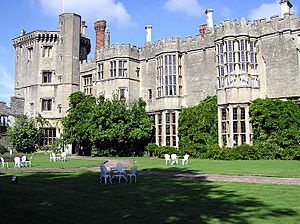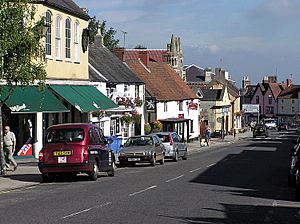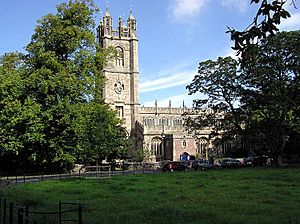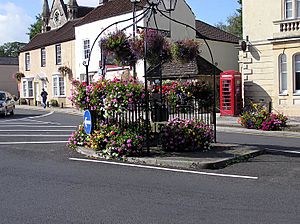Thornbury, Gloucestershire facts for kids
Quick facts for kids Thornbury |
|
|---|---|
| Market town | |
 Thornbury Town Hall |
|
| Population | 14,496 (2021 census) |
| OS grid reference | ST636902 |
| Unitary authority | |
| Ceremonial county | |
| Region | |
| Country | England |
| Sovereign state | United Kingdom |
| Post town | BRISTOL |
| Postcode district | BS35 |
| Dialling code | 01454 |
| Police | Avon and Somerset |
| Fire | Avon |
| Ambulance | Great Western |
| EU Parliament | South West England |
| UK Parliament |
|
Thornbury is a lively market town in South Gloucestershire, England. It is located about 12 miles (19 km) north of the city of Bristol. In 2021, about 14,496 people lived there.
Thornbury is famous for its beautiful flowers. It has won awards in the "Britain in Bloom" competition. The town even has its own local flower contest called "Thornbury in Bloom." The earliest records of a village here, called "Thornbyrig," date back to the late 800s. The Domesday Book of 1086 mentioned "Turneberie" as a manor. It belonged to Matilda of Flanders, who was the wife of William the Conqueror. Back then, 104 people lived in the manor.
Contents
A Look at Thornbury's Past
People have lived in the Thornbury area for a very long time. There is proof of human activity from the Neolithic (New Stone Age) and Bronze Age periods. We know Romans were here too. In 2004, a large collection of 11,460 Roman coins was found. These coins were made between 260 and 348 CE.
The oldest building still standing is St Mary's Church. It was started in the 12th century, with parts added later. Thornbury was given a special town charter in 1252. This allowed it to hold markets and fairs. The town grew around its busy cattle market.
Thornbury stopped being a "borough" in the 1800s. But in 1974, its local council decided to call itself a "town council" again. This was a new right they had.
The old parish of Thornbury was very large. It stretched all the way to the River Severn. Some parts, like Rangeworthy, became separate areas later. Other parts, like Oldbury-on-Severn and Falfield, also became their own parishes in 1894.
Thornbury, Pennsylvania, in the USA, was named after Thornbury, Gloucestershire. It was founded in 1687 by George Pearce. His wife, Ann, came from Thornbury. An important medical discovery was linked to Thornbury. In 1765, Dr. John Fewster from Thornbury wrote about "Cow Pox" preventing "Smallpox." His ideas helped his friend, Edward Jenner, who created the first smallpox vaccine.
Thornbury used to have a railway line. It connected to Yate and then to Bristol and Gloucester. Passenger trains stopped running in 1944. The railway line was then used only for goods. Today, the old station area has been redeveloped. It is now a supermarket, houses, a bypass road, and a long footpath. There are talks about reopening the railway line in the future.
The town used to have a large market in the high street. This market closed in the late 1990s. A smaller market now operates in a car park. The old market hall is now a restaurant. A new community centre called "Turnberrie's" was built on the old market site.
Thornbury's coat of arms shows symbols from four important families. These families were the Attwells, Howard, Clare, and Stafford. They were very important in the town's history. The town's motto is Decus Sabrinae Vallis. This means "Jewel of the Severn Vale" in Latin.
Where is Thornbury?
Thornbury is located in the lower Severn Valley area. This is in South Gloucestershire. The town also includes an area called Morton. Morton is split into Upper and Lower Morton. These are areas of farmland to the north-east of Thornbury.
Things to Do and See
Thornbury has a main shopping street, a shopping centre (St Mary's Centre), and two supermarkets. You can find many smaller shops too. There are several churches in the town. These include St Mary's Church, the Catholic Church, and the Methodist Church.
The town has many pubs. The White Lion pub on the High Street won an award for its flower display in 1999. There are also restaurants, including one at Thornbury Castle.
Thornbury has its own radio station called Thornbury Radio. You can listen to it on 105.1 and 107.5 FM. It also broadcasts online.
A special group for adults with autism or Asperger syndrome meets weekly in Thornbury. It is called South Glos Aspies. Thornbury also has a market garden. It grows vegetables using natural methods for local people.
Music and Drama Groups
The Armstrong Hall is the biggest place for music and drama shows. It can seat 350 people. The Cossham Hall next door seats 140. Local groups also perform in church halls. Some of the amateur groups are:
- Thornbury Musical Theatre Group (TMTG): They put on musicals, pantomimes, and concerts.
- North Avon Youth Theatre (NYTC): This group performs a show every April.
- Octopus Thornbury: This drama group performs shows in June, October, and January.
- Thornbury Area Music Trust (TAMT): This group runs music classes for young people aged 4–18.
- The South Cotswold Youth Orchestra (SCYO): This orchestra is for musicians who are Grade 5 level or higher.
Jobs in Thornbury
One of the largest companies in Thornbury is Essilor. It is located in the industrial area in the south of the town. Essilor makes lenses for eyeglasses.
Main Roads and Streets
- The B4061 road goes through the centre of Thornbury. It connects to the A38 road to the north and south.
- Gillingstool and Grovesend Road link the town centre to the A38 road in the east.
- The High Street is a main road on the western side of town.
- The Plain is at the north end of the High Street. It has a famous old pump in the middle of the road.
- Castle Street goes north from The Plain to Thornbury Castle and St Mary's Church.
- Midland Way and Morton Way are newer roads. They form a semi-circle around the east of the town. These roads help large trucks avoid the town centre.
Places to Visit

You can find a tourist information centre in the Town Hall. It is open on weekdays.
Thornbury Castle
Thornbury Castle is a very famous building in the town. It is a Tudor castle that was started in 1511. It was built as a home for Edward Stafford, 3rd Duke of Buckingham. The castle has two beautiful red brick chimneys. They were built in 1514 and look like those at Hampton Court Palace.
The Duke was executed in 1521. After that, King Henry VIII took the castle for himself. King Henry VIII even stayed there for ten days in 1535 with Anne Boleyn. The castle became damaged after the English Civil War. But it was fixed up in 1824. Today, Thornbury Castle is a hotel and restaurant. It has 27 rooms.
St Mary's Church
The Anglican Church of Saint Mary the Virgin began being built in 1340. More parts were added in 1500, 1848, and 1988. People still use the church for regular services, weddings, and other events. The local primary school, St Mary's CEVA Primary, also holds its celebrations there.
The church is the resting place of Jasper Tudor's internal organs. He was the uncle of Henry VII of England. The church is a Grade I listed building, which means it is a very important historic building.
The Town Pump
You can see the town pump on a small island at the end of the High Street. It has a hand pointing "To Gloucester." The first pump was removed in 1924 because it was a danger on the road. A new one was built in 1984. It was painted gold in 2002 to celebrate the Golden Jubilee. The pump is often decorated with flowers.
Walks and Scenery
The Streamside Walk is a footpath that starts near Gillingstool Primary School. It goes past Thornbury Hospital and Manorbrook Primary School. Another stream runs through the north-east of Thornbury.
The old railway line is now a footpath. It was created in the 1990s. It follows the route of Streamleaze and Avon Way.
The "heritage trail" was created by the Thornbury and District Heritage Trust. It helps you explore the town's historic buildings. There are 40 markers that show you the way. The trail starts outside the town hall.
Sports and Leisure
Mundy Playing Fields were given to the town in 1937. They have a children's play area and sports grounds. Nearby, you can find Thornbury Golf Club, Thornbury Leisure Centre, and a skate park. There are also green spaces around the town.
Thornbury RFC is the town's rugby club. They play in the South West 1 League. Their home ground is in Rockhampton, just outside Thornbury.
Thornbury Town FC is the main football club. Football has been played in Thornbury since 1896. The youth section, called Thornbury Falcons, started in 1990. In 2010, the two clubs joined together to form the new Thornbury Town FC. The First Team plays in the Hellenic League Premier Division. This is the ninth level of English football. They play their home games at Mundy Playing Fields.
Real Thornbury FC is another football club. It was started in 2007. They play at Oaklands Park in Almondsbury.
Other Attractions
Other interesting places include Filnore Woods, Armstrong and Cossham Halls, and Thornbury Museum. The heritage trail gives information about important places. It starts at the town hall. The MacLaine Memorial Fountain remembers Lieutenant Hector MacLaine. He was a local man who helped protect the British in India in 1880.
Twin Town
Thornbury is twinned with Bockenem in Germany. This means the two towns have a special friendship.
Schools in Thornbury
The Castle School is Thornbury's secondary school. The old Thornbury Grammar School buildings are now its sixth-form centre. Thornbury Grammar School moved to new buildings in Alveston in 1972. It was then renamed Marlwood School.
Gillingstool Primary School opened in 1862. It is known for its school bell. The school was rebuilt starting in 2009. Its old Victorian buildings were kept.
St Mary's Church of England Primary School started in 1839. It recently celebrated its 175th anniversary. Children dressed in old-fashioned clothes for a Victorian Week. Other schools include Crossways Infant and Junior schools, Christ the King Roman Catholic Primary School, and Manorbrook Primary School. There are also special schools like New Siblands Special School and the Sheiling School.
Getting Around
The T1 Bristol–Thornbury bus route offers regular services to Bristol.
Famous People from Thornbury
Many interesting people have connections to Thornbury:
- Beverley Robinson (1723–1792), an American loyalist, died in Thornbury.
- John Rolph (1793–1870), a Canadian politician, was born here.
- George Rolph (1794–1875), another Canadian politician, was also born here.
- Handel Cossham (1824–1890), a politician, was born in Thornbury.
- E. M. Grace (1841–1911), a famous cricketer, played for Thornbury Cricket Club.
- W. N. Hodgson (1893–1916), a war poet, was born in Thornbury.
- Tony Britton (1924–2019), an actor, went to the grammar school.
- Sarah Singleton (born 1966), a novelist and children's writer, was born here.
- John Robins (born 1982), a comedian, grew up in Thornbury.
- Emily Webley-Smith (born 1984), a tennis player, was born in Thornbury.
- Matthew Kane (actor) (born 1991), an actor, lived and grew up here.
- Mako Vunipola (born 1991), a rugby player, lived here and went to The Castle School.
- Billy Vunipola (born 1992), also a rugby player, lived here and went to The Castle School.
Images for kids
See also
 In Spanish: Thornbury para niños
In Spanish: Thornbury para niños













